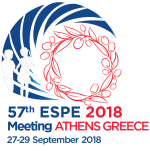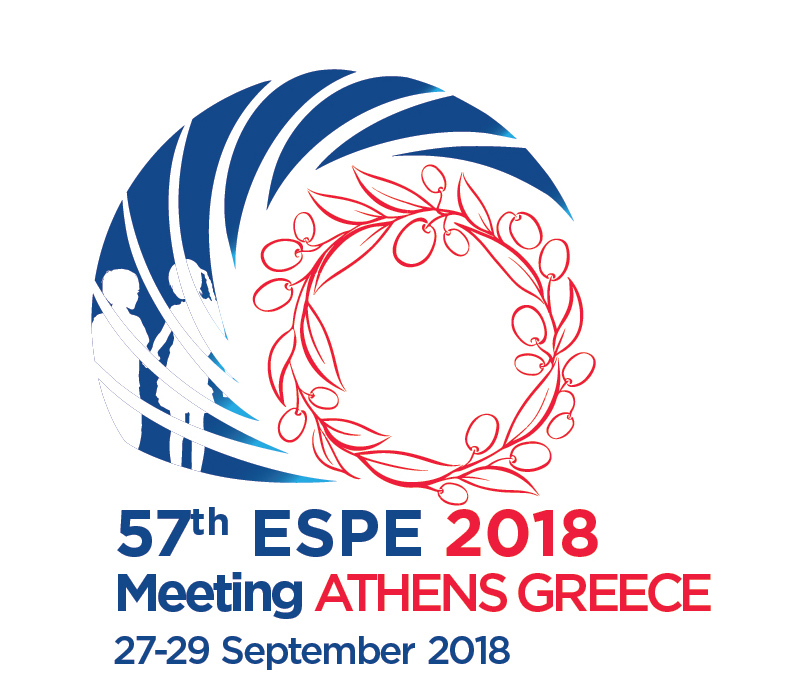
57th Annual ESPE
Athens,
Greece
27 Sep 2018 - 29 Sep 2018

Poster Presentations
Adrenals and HPA Axis P3
hrp0089p3-p001 | Adrenals and HPA Axis P3 | ESPE2018
Congenital Adrenal Hyperplasia: A Patient’s Perspective, a Mother’s Story
hrp0089p3-p002 | Adrenals and HPA Axis P3 | ESPE2018
An Extremely Rare Cause of Cushing Syndrome in Chidhood
hrp0089p3-p003 | Adrenals and HPA Axis P3 | ESPE2018
Nelson’s Syndrome after Bilateral Adrenalectomy for Cushing’s Disease in Pediatric Age – Report of a Case
Machado Catarina M , Leite Ana L , Sousa Ana , Almeida Lucia , Campos Rosa Armenia , Oliveira Maria Joao , Marques Jorge Sales
hrp0089p3-p004 | Adrenals and HPA Axis P3 | ESPE2018
Basal Levels of 17-hydroxyprogesterone can Distinguish Isolated Precocious Pubarche from Non-Classical Congenital Adrenal Hyperplasia in Children: A Prospective Observational study
Grandone Anna , Festa Adalgisa , Mariani Michela , Luongo Caterina , Giudice Emanuele Miraglia del
hrp0089p3-p005 | Adrenals and HPA Axis P3 | ESPE2018
Age at Diagnosis and Outcome in Maghreb patients with 21-hydroxylase Deficient Congenital Adrenal Hyperplasia; Urgent need for Newborn Screening
Ladjouze Asmahane , Yala Imane , Yahiaoui Manel , Zerguini Dounia , Tardy Veronique , Mohammedi Kahina , Taleb Ourida N , Kerkouche Soraya , Berkouk Karima , Bensmina Manoubia , Maoudj Abdeljlil , Aboura Rawda , Anane Tahar , Morel Yves , Bouzerar Zahir
hrp0089p3-p006 | Adrenals and HPA Axis P3 | ESPE2018
An Adrenal Tumor Ppresenting as a Premature Pubarche in a 7 Year-old Girl
Marie-Neige Campas-Lebecque , Isabelle Souto , Stephanie Proust , Marc-David Leclair , Valentine Suteau , Justine Bailleul , Maryam Azgal , Natacha Bouhours-Nouet , Regis Coutant
hrp0089p3-p007 | Adrenals and HPA Axis P3 | ESPE2018
Refractory Cyclical Cushing’s Disease - a Case of Multiple Pituitary Micro-adenomas in a Three Year Old Girl after 8 Years Follow up
Robinson Elizabeth , Poonam Poonam Dharmaraj , Heyningen Carl van
hrp0089p3-p008 | Adrenals and HPA Axis P3 | ESPE2018
Topical Corticosteroid-Induced Adrenal Insufficiency
Ghaddhab Chiraz , Carine Beaufort
hrp0089p3-p009 | Adrenals and HPA Axis P3 | ESPE2018
Early Diagnosis of Duchenne Muscular Dystrophy in 6-Months-Old Male with Primary Adrenal Insufficiency
Yanar Eda , Kopylova Irina , Kanivets Ilya , Korostelev Sergey , Pyankov Denis , Zakharova Ekaterina , Kareva Maria , Orlova Elizaveta
hrp0089p3-p010 | Adrenals and HPA Axis P3 | ESPE2018
Lipoid Adrenal Hyperplasia Diagnosed with Severe Cholestasis in Newborn
Kaplan Emel Hatun Aytac , Melekoğlu Nuriye Aslı , Keskin Mehmet , Cağatay Derya , Karaer Kadri
hrp0089p3-p011 | Adrenals and HPA Axis P3 | ESPE2018
Severe Hyponatraemia with Absence of Hyperkalaemia in a Patient with Addison’s Disease
Doneray Hakan , Ozden Ayse , Kizilelma Nagihan Erol
hrp0089p3-p012 | Adrenals and HPA Axis P3 | ESPE2018
Deep Bronze Skin without Sun Exposition in a 16-Year Old Girl
Jasser-Nitsche Hildegard , Loffler Sabine , Suppan Elisabeth , Weinhandl Gudrun , Frohlich-Reiterer Elke
hrp0089p3-p013 | Adrenals and HPA Axis P3 | ESPE2018
Case of Primary Pigmented Nodular Adrenocortical
hrp0089p3-p014 | Adrenals and HPA Axis P3 | ESPE2018
Two Case Report of Adrenocortical Adenoma
hrp0089p3-p015 | Adrenals and HPA Axis P3 | ESPE2018
A Homozygous Mutation c.518T>A (p.lle173Asn) of the CYP21A2 Gene Presenting as Non-Classical Congenital Adrenal Hyperplasia (NCAH)
Karamfilova Teodora , Stoeva Iva , Mihova Kalina , Kaneva Rada , Tsochev Kaloyan , Iotova Violeta
hrp0089p3-p016 | Adrenals and HPA Axis P3 | ESPE2018
Adrenals and HPA Axisa; Atypical Presentation of Adrenal Insufficiency
hrp0089p3-p017 | Adrenals and HPA Axis P3 | ESPE2018
Non-classic Congenital Adrenal Hyperplasia Causing Alleles among Adolescent Girls with PCOS – Genetical Study
Lidaka Lasma , Lazdāne Gunta , Gailīte Linda , Dzivite-Krisane Iveta
hrp0089p3-p018 | Adrenals and HPA Axis P3 | ESPE2018
Adequate Interpretation of Cortisol Levels in Children
Chueca Maria J , Villarreal Maria , Andres Carlos , Berrade Sara , Dura Teodoro , Nova Luiz-Miguel , Rodriguez Pablo
hrp0089p3-p019 | Adrenals and HPA Axis P3 | ESPE2018
Erythrocytosis as First Manifestation of Adrenal Mass
Valenzise Mariella , Cannavo Laura , Zirilli Giuseppina , Iaria Graziella , Lima Mario
hrp0089p3-p020 | Adrenals and HPA Axis P3 | ESPE2018
A Neonatal Case with Familial Glucocorticoid Deficiency Type 1 Having Adrenal Crisis in Early Period
Keskin Mehmet , Koklu Esat , Kaplan Emel H Aytac , Karaoglan Murat , Karaer Kadri , Keskin Ozlem
hrp0089p3-p021 | Adrenals and HPA Axis P3 | ESPE2018
Presenting Features, Clinical Characteristics and Follow up of Familial Isolated Glucocorticoid Deficiency (FGD) due to Mutations in MC2R and MRAP Genes
Ozbek Mehmet Nuri , Karaşin Nezehat Doğan , Demirbilek Huseyin , Demiral Meliha , Baran Rıza Taner , Guran Tulay
hrp0089p3-p022 | Adrenals and HPA Axis P3 | ESPE2018
Identification of X-linked Adrenoleukodystrophy in Boys Presenting with Adrenal Insufficiency in the Absence of Adrenal Antibodies
Ryalls Michael , Gan Hoong-Wei , Biedenkapp Joe , Davison James
hrp0089p3-p023 | Adrenals and HPA Axis P3 | ESPE2018
Secondary Hyperaldosteronism in the Course of Cystic Fibrosis
Erazmus Michał , Kucharska Anna
hrp0089p3-p024 | Adrenals and HPA Axis P3 | ESPE2018
The P30L Mutation in the CYP21A2 Gene in a Girl with Congenital Adrenal Hyperplasia with Hidden Salt Loosing and Central Precocious Puberty
Akulevich Natallia , Boiko Julia , Mirabelli Silvestro , DeLuca Filippo , Wasniewska Malgorzata
hrp0089p3-p025 | Adrenals and HPA Axis P3 | ESPE2018
Congenital Adrenal Hyperplasia due to a Rare Homozygous Mutation R483P in the CYP21A2 Gene and Coexisting Growth Hormone Deficiency
Akulevich Natallia , Makarava Yulia , Boiko Julia , Mirabelli Silvestro , Wasniewska Malgorzata , DeLuca Filippo
hrp0089p3-p026 | Adrenals and HPA Axis P3 | ESPE2018
Rare Case of Androgen Producing Tumor in 14 Month Old Girl
Kheladze Nino , Lundberg Elena , Totogashvili Nino , Tkeshelalashvili Tinatin
hrp0089p3-p027 | Adrenals and HPA Axis P3 | ESPE2018
Adrenocortical Tumours in Children – A Case Series
Hua Chan Si , Farhad Vasanwala Rashida
hrp0089p3-p028 | Adrenals and HPA Axis P3 | ESPE2018
Discrete Virilization in Girls with the Classic Form of Congenital Adrenal Hyperplasia: the Importance of a Detailed Genital Examination at Birth
Santos Silva Chagas Leticia , Guerra-Junior Gil , Palandi De-Melo Maricilda , Helena Valente Lemos-Marini Sofia
hrp0089p3-p029 | Adrenals and HPA Axis P3 | ESPE2018
A New Methodology for Early Identification of Steroid Resistant Acute Graft-Versus-Host Disease Patients
Gillio Alfred , Krajewski Jennifer , Donato Michele , Durning Nancy , Haugh Jeanette , Balboul Sarah , Ghanny Steven
hrp0089p3-p030 | Adrenals and HPA Axis P3 | ESPE2018
Delayed Diagnosis of a Patient with Antley-Bixler Syndrome
Kirkgoz Tarik , Bas Serpil , Yavas Abali Zehra , Turan Serap , Bereket Abdullah , Guran Tulay
hrp0089p3-p404 | Adrenals and HPA Axis P3 | ESPE2018
Clinical and Biochemical Phenotype of Aldosterone Synthase Deficiency
Fortsch Katharina , Doing Carsten , Wudy Stefan A , Hartmann Michaela F , Martin Holterhus Paul , Mayatepek Ertan , Reinauer Christina , Meissner Thomas , Kummer Sebastian
hrp0089p3-p414 | Adrenals and HPA Axis P3 | ESPE2018
Is the Third Time Really a Charm? The Story about Three Brothers Suffering from Adrenoleukodystrophy and about HSCT being a Chance to Stop the Unstoppable Disease
Hetman Marta , Kalwak Krzysztof , Barg Ewa



